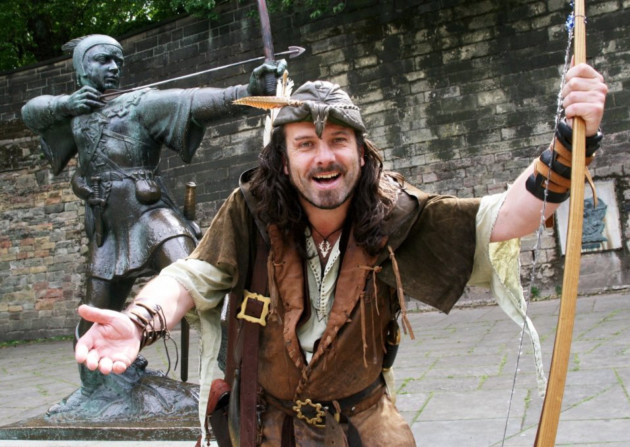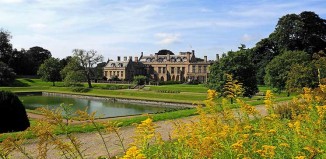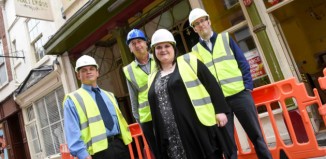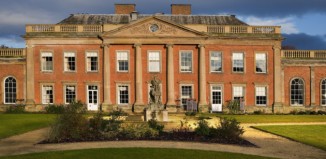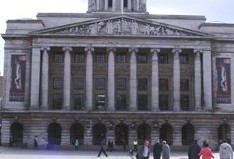Discover Nottingham’s architectural gems
Admire the old, new and fairytale-esque during a tour of five inspired Nottingham buildings, escorted by its legendary outlaw, Robin Hood
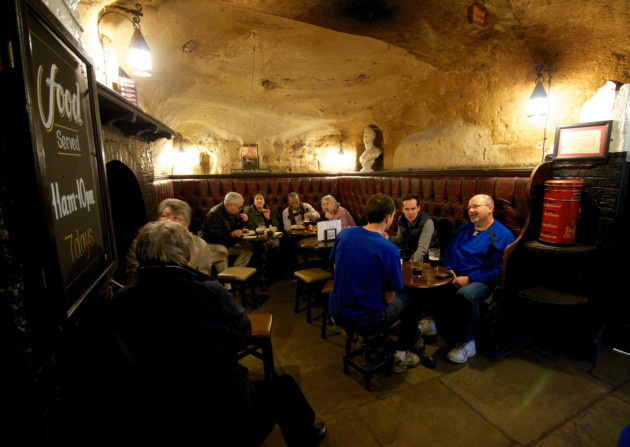
Ye Olde Trip to Jerusalem, Nottingham. ©Diana Jarvis/Visit England
A tour of Nottingham’s diverse architecture, ranging from the medieval to modern, provides a snapshot of the development of this small Midlands city. The first settlement was established on the banks of the River Trent in the sixth century by the Danes, who quickly realised the potential of this fertile location. A community grew steadily, its wealth in the Middle Ages deriving from tanning, the wool trade, beer brewing and framework-knitting industries.
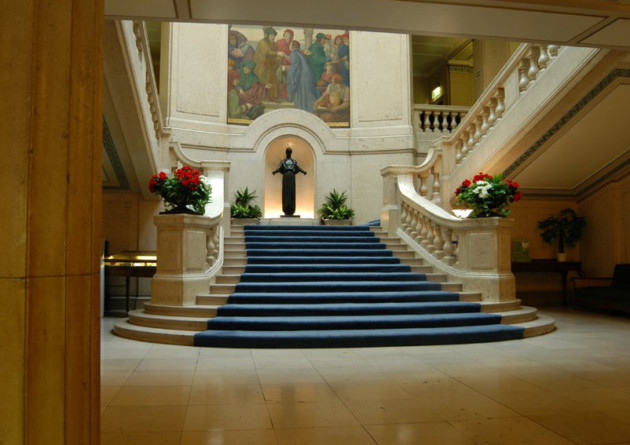
Council House
Today, relics of the Saxon, Norman and medieval eras remain across the city, while the river continues to play a significant role in local life – once a vital trade link it is now a playground for boaters, canoeists and fishermen.
The cloth industry superceded the wool trade and lace-making was big business from the early 18th century, only faltering in Victorian times as demand declined. The city than slid a little until regeneration began in earnest during the 1980s, reviving local fortunes. Tourism was an unexpected bonus, with visitors drawn by the legend of outlaw Robin Hood and his nearby stomping ground, Sherwood Forest. Today, holiday-makers can enjoy the best of the city accompanied by a guide dressed as the folk figure, revealing how the hooded man evolved to become a modern-day hero.
Nottingham Castle
Lenton Road
Architect: William Peveril; William Cavendish
Built: 1067; rebuilt 1674-79
When visitors arrive in Nottingham, one of the first attractions on their wish-list is the castle – fabled site of skirmishes between Robin Hood and his nemesis, the Sheriff of Nottingham – the outlaw said to have repeatedly escaped from the dungeons here with the aid of his Merry Men. In recorded history the castle was an important site for generations of royals, among them Richard III. Yet this fortress, which sits on a craggy outcrop overlooking the city, is not the one many expect to find, grand as it may be. Its medieval origins lie far beneath the 17th-century ducal mansion that now stands here. As early as 1525 the castle was decaying and a century later it was completely uninhabitable, having been unceremoniously stripped of its last assets by the noble Manners family, who leased the building from 1622. During the Civil War the fort was one of Charles I’s last safe havens – the king eventually fleeing to Newark Castle where he surrendered in 1646. Keen to prevent its re-use as a royal stronghold, Cromwell’s government saw to the dismantling of centuries of history, stone by stone. It was rebuilt for William Cavendish, First Duke of Newcastle in 1674-79 and by 1878 was transformed and opened as a museum and art gallery for the city. Most recently a funding bid is underway with hopes to secure state-of-the-art interpretation of Nottingham’s most pivotal events.
Council House
Old Market Square
Architect: Thomas Cecil Howitt
Built: 1926-9
This grandiose central landmark has been likened to
St Paul’s Cathedral owing to its impressive 200ft-high domed roof, while its façade is a vision of Classical architecture, flanked by two imposing lions guarding the main entrance. Viewed from across the Old Market Square similarities can be drawn with piazzas of Italian cities. The building comprises not only the requisite council offices and committee rooms, but a lavish shopping arcade, the Exchange, which was modelled on the Galleria Vittorio Emanuele in Milan. At the heart of the Exchange, look up to admire a series of murals illustrating the evolution and character of Nottingham, created in 1929: one shows King Snot of Denmark who first settled the land in the sixth century; William the Conqueror stands watchful of the building of the castle; Robin Hood can be seen firing an arrow at an unseen target, and Charles I, gracing the ceiling artwork, features the defiant king who raised his standard at the castle in 1642. Perhaps most impressive of all is the clock tower. On the hour the bell, known as ‘Little John’, strikes with a toll reminiscent of London’s Big Ben.
Watson Fothergill’s Office
15 George Street
Architect: Watson Fothergill
Built: 1894-5
A couple of streets of Nottingham are blessed with the fairytale design of Victorian architect Watson Fothergill, who added some 100 buildings to the city between 1870 and 1906. His trademark lies in the characteristic red and blue brickwork woven throughout his Neo-Gothic façades; his preference for the avant-garde shaping a variety of domestic and public buildings including banks, almshouses, churches and hotels, each embellished with carvings, friezes and other grand flourishes. Post-war his eccentric work was considered vulgar, and much of his legacy was wiped from the face of the city. Fothergill’s office is a lasting representation of his work: church-like in appearance it features stone carvings, spires, colourful brickwork and an oriel window. A second Fothergill masterpiece can be seen on the corner of Queen Street and Long Row, off the Old Market Square. Queen’s Chambers was designed as a shop and office space and combines all the drama of Tudor and Gothic style with towering chimneys, black and white gables, oriel windows and the signature Fothergill red and blue brick.
Shire Hall
High Pavement
Architect: James Gandon and TC Hine
Built: 1770-2; refurbished 1876-8
This former law court has history embedded within the steps outside, where criminals were once hanged in front of a public audience in Victorian times. The attractive honeyed sandstone façade seen today was inspired by French Neoclassical architecture and embellished by local architect Thomas Chambers Hine in the 19th century.Serving as a court and county gaol from the 14th century, the inhumanity meted out within its walls can only be imagined. In the deepest, darkest recesses of the old prison lies an oubliette, a pit carved into the sandstone foundations into which the condemned were thrown. In the ancient ballad, Robin Hood and the Monk, this was where our hero was imprisoned. The Hall ceased operation as a courthouse in 1985 and was transformed into the Galleries of Justice Museum, where you can find free exhibitions on crime, punishment and Robin Hood, as well as new ghost and terror tours.
Ye Olde Trip to Jerusalem Inn
Brewhouse Yard
Architect: Unknown
Built: Early 17th century
Fixed into the base of Castle Rock, Ye Olde Trip to Jerusalem is said to be England’s oldest inn. The date AD1189 emblazoned on the exterior wall is in reference to Richard I’s accession to the throne, while the unusual name originates from the Crusades in Jerusalem fought during his reign. The inn was said to be a rallying point for the king’s knights before their departure for holy war.
An ale and a sit down in the Rock Lounge are recommended to take in the whole picture, for what appears to be a typical quaint pub morphs somewhere along a passageway into a troglodyte world. Above your head a cave ‘ceiling’ appears and disappears, while far beneath your feet a network of cellars link to the castle. These once doubled as a place for servants of the citadel to place their orders for the king’s favourite tipple, and a grim prison. Cellar tours run throughout the week and give a flavour of what life would have been like for those banished here. Visitors may also like to explore the notorious cave tunnel known as Mortimer’s Hole, which leads from Brewhouse Yard to the top of Castle Rock, and which was famously used to capture the fortress from the controversial Sir Roger de Mortimer in 1330.
Contact: Nottingham TIC, 1-4 Smithy Row, Nottingham. Tel: 0844 477 5678; www.experiencenottinghamshire.com
Book Robin Hood’s heritage tours of the city and Sherwood Forest direct at www.ezekialbone.com or call 07941 210 986, or visit www.experiencenottinghamshire.com

